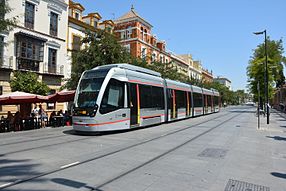Tram Seville
| Tram Seville (MetroCentro) | |
|---|---|
| Urbos 3 tram car on Calle San Fernando | |
| Basic information | |
| Country | Spain |
| city | Seville |
| opening | October 28, 2007 |
| operator | TUSSAM |
| Infrastructure | |
| Route length | 2.2 km |
| Gauge | 1435 mm ( standard gauge ) |
| Power system | 750 V DC overhead line / battery |
| Stops | 5 |
| business | |
| Lines | 1 |
| Clock in the peak hours | 7 min |
| vehicles | 5 CAF Urbos 3 |
| Top speed | 70 km / h |
The MetroCentro is a tram in the Andalusian capital Seville ( Spain ). It has been in operation since October 2007 and currently has a single line.
The current route has five stops: Plaza Nueva, Archivo de Indias, Puerta de Jerez, Prado de San Sebastián and San Bernardo. This section of the route is just the beginning of a planned network in the city center. The line is to be continued to Santa Justa Central Station. Four more stops are planned along the way: San Francisco Javier, Eduardo Dato, Luis de Morales and finally Santa Justa. In a further phase, the route will then be expanded in the other direction via Plaza Nueva to Puente Osario.
The concrete planning of the Seville tram system began in mid-2005 after it had been discussed for years. The opening of the section from Plaza Nueva to Prado de San Sebastián took place on October 28, 2007; the extension to San Bernardo was opened on April 15, 2011. The route is around 2 km long and is served every seven minutes during rush hour. The depot is attached to the Prado de San Sebastían bus station.

The section of the route opened in 2007 - a total of € 60.5 million - was financed by the regional government of Andalusia (€ 40.9 million) and the city council of Seville (€ 19.6 million).
The CAF Urbos 2 vehicles in use until 2011 are 31 meters long and offer space for 275 passengers. The maximum speed is 70 km / h. They are identical to the vehicles used on Line 1 of the Seville Metro .
The new CAF Urbos 3 were supplied with the ACR battery option ( Acumulador de Carga Rápida ) - until then, the operator had the requirement to remove the overhead line during traditional processions. With the commissioning at Easter 2011, the overhead line in the vicinity of the cathedral could be removed. The CAF Urbos 2 that were in use until then have been running on the metro routes since then.
Individual evidence
- ↑ The tram at urbanrail.net
- ↑ tramvia.org on the Seville tram
- ↑ The manufacturer CAF on his vehicle (1) ( Memento of the original from October 2, 2010 in the Internet Archive ) Info: The archive link was automatically inserted and not yet checked. Please check the original and archive link according to the instructions and then remove this notice.
- ↑ The manufacturer CAF on his vehicle (2) ( Memento of the original from October 2, 2010 in the Internet Archive ) Info: The archive link was automatically inserted and not yet checked. Please check the original and archive link according to the instructions and then remove this notice.
- ↑ Jens Perbandt: Andalusia Metro . In: Tram magazine . No. 2 , 2010, p. 61 ff .
- ↑ http://www.diariodesevilla.es/article/sevilla/656857/las/catenarias/seran/desmontadas/este/fin/semana/cara/la/semana/santa.html

